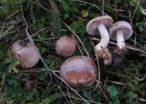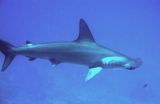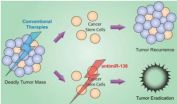(Press-News.org) A new fungal species, called 'Hebelomagriseopruinatum', has now officially been included in the list of species. The fungus, whose name can be translated into 'the grey-dewy tear leaf', was discovered on Zealand in Denmark during a mushroom-hunting tour headed by postdoc Jacob Heilman-Clausen from the University of Copenhagen.
During a mushroom-hunting excursion in 2009, postdoc Jacob Heilman-Clausen from the Center for Macroecology, Evolution and Climate at the Department of Biology, University of Copenhagen, was handed a very interesting looking fungus.
Following thorough expert studies, the fungus has now officially been classified as a novel species.
The fungus has been sighted once before in both England and Germany, but has not been described until the Danish discovery. The scientific description of the fungus has just been published in the journal Fungal Diversity.
"We regularly discover species never previously seen in Denmark, but it is quite extraordinary when a Danish fungus is described as new to the world," says postdoc Jacob Heilman-Clausen.
Intimate cohabitation with plant
The fungus was discovered in Eskebjerg Vesterlyng, an area of natural beauty with old grassy areas and scrub rich in species. Here, the species leads an intimate life with the sun rose plant in the same way as popular edible fungi like chantarelles, boletuses and truffles, which depend on cohabitation with trees.
The new species will, however, hardly be a welcome ingredient in your dinner, as several closely related species are toxic, and according to the researchers this also applies to the new species.
"Edible fungi are very popular in Denmark, but only few people realise that fungi serve important functions in nature. They degrade dead material and ensure that nutrients are circulated to the system. And yet we still know very little about how many fungal species exist worldwide. Even in Denmark, there are still many discoveries like this waiting to be made," says Jacob Heilman-Clausen.
Voluntary fungal enthusiasts valuable to science
The new fungal species was registered by the Danish Fungus Atlas (Danmarks Svampeatlas in Danish), which uses voluntary enthusiasts to map Denmark's fungi.
During the first three project years, some 160,000 discoveries of more than 2,000 species have been entered in the project database, including several species not previously seen in Denmark.
Scheduled to run until 2014, the Danish Fungus Atlas project receives funding from the Aage V. Jensens Naturfond foundation. According to Jacob Heilman-Clausen, there are good opportunities for describing several new species:
"This is the most thorough study of Danish fungi ever. Thanks to the efforts of the volunteers, we will be able to achieve a lot during the short project period. In my opinion, there are many discoveries to be made."
INFORMATION:
The scientific description of Hebelomagriseopruinatum is published online in the journal Fungal Diversity: http://www.springerlink.com/content/4v45343715263602/?MUD=MP
New Danish fungal species discovered
2012-09-04
ELSE PRESS RELEASES FROM THIS DATE:
Simple tool may help inexperienced psychiatrists better predict violence risk in patients
2012-09-04
Inexperienced psychiatrists are less likely than their veteran peers to accurately predict violence by their patients, but a simple assessment checklist might help bridge that accuracy gap, according to new research from the University of Michigan.
Led by psychiatrist Alan Teo, M.D., a Robert Wood Johnson Foundation Clinical Scholar of the University of Michigan, researchers examined how accurate psychiatrists were at predicting assaults by acutely ill patients admitted to psychiatric units.
Their results found that inexperienced psychiatric resident doctors did no ...
Shark rules need teeth, groups tell IUCN
2012-09-04
WCS invests in a diverse array of long term, seascape-scale and species-focused conservation strategies across the waters of 20 countries and all five oceans. We inspire millions to take action for the oceans through the New York Aquarium and all our parks in New York City. To achieve our long-term conservation goals, WCS marine conservationists work with local and national governments, as well as an array of partners to improve management of coastal fisheries, mitigate key threats to marine species, expand effective marine protected areas, enhance ocean industry sustainability, ...
Review finds some evidence for 'chemo brain' in breast cancer survivors, Moffitt Cancer Center says
2012-09-04
A large meta-analysis conducted by researchers at Moffitt Cancer Center has concluded that breast cancer patients treated with chemotherapy are at risk for mild cognitive deficits after treatment. The meta-analysis, or analytic review of previously published studies, found that study participants on average had mild impairments in verbal abilities (such as difficulty choosing words) and visuospatial abilities (such as getting lost more easily). The study noted that cognitive functioning varies across survivors, with some reporting no impairments and others reporting more ...
A*STAR scientists discover potential drug for deadly brain cancer
2012-09-04
1. A*STAR scientists have identified a biomarker of the most lethal form of brain tumours in adults- glioblastoma multiforme. The scientists found that by targeting this biomarker and depleting it with a potential drug, they were able to prevent the progression and relapse of the brain tumour.
2. This research was conducted by scientists at A*STAR's Institute of Medical Biology led by Dr Prabha Sampath, Principal Investigator, in collaboration with A*STAR's Bioinformatics Institute (BII), and clinical collaborators from Medical University of Graz, Austria, and National ...
Experts propose 'cyber war' on cancer
2012-09-04
HOUSTON -- (Sept. 4, 2012) -- In the face of mounting evidence that cancer cells communicate, cooperate and even engage in collective decision-making, biophysicists and cancer researchers at Rice University, Tel Aviv University and Johns Hopkins University are suggesting a new strategy for outsmarting cancer through its own social intelligence.
"We need to get beyond the notion that cancer is a random collection of cells running amok," said Herbert Levine, co-director of Rice's Center for Theoretical Biological Physics (CTBP) and co-author of the cover article in this ...
Every atom counts in graphene formation
2012-09-04
HOUSTON – (Sept. 4, 2012) – Like tiny ships finding port in a storm, carbon atoms dock with the greater island of graphene in a predictable manner. But until recent research by scientists at Rice University, nobody had the tools to make that kind of prediction.
Electric current shoots straight across a sheet of defect-free graphene with almost no resistance, a feature that makes the material highly attractive to engineers who would use it in things like touchscreens and other electronics, said Rice theoretical physicist Boris Yakobson. He is co-author of a new paper about ...
More than 70% of electronic waste management is uncontrolled
2012-09-04
Almost three quarters of disposed electrical household appliances in Spain are processed out of the Integrated Waste Management System (SIG). A study at the University of Salamanca exposes how many manufacturers are not registered in the established waste management system and avoid payment.
According to the European directive on waste electrical and electronic equipment, manufacturers of such products should recycle the waste they generate during their activity until reaching an annual level of 4 kg per inhabitant. However, in Spain the majority of unused equipment is ...
Major world interests at stake in Canada's vast Mackenzie River Basin
2012-09-04
The governance of Canada's massive Mackenzie River Basin holds enormous national but also global importance due to the watershed's impact on the Arctic Ocean, international migratory birds and climate stability, say experts convening a special forum on the topic.
"Relevant parties in western Canada have recognized the need for a multi-party transboundary agreement that will govern land and water management in the Mackenzie River watershed. Successful collaboration will effectively determine the management regime for a watershed covering 1.8 million square kilometers or ...
Annals of Internal Medicine tip sheet for Sept. 4, 2012
2012-09-04
1. No Nutritional or Safety Differences Between Organic and Conventional Foods
There is generally no difference in nutritional value or risk for bacterial contamination between organic and conventional foods, according to a new study being published in Annals of Internal Medicine, the flagship journal of the American College of Physicians (ACP). While the consumption of organic fruits and vegetables reduced exposure to any detectable pesticide residues by 30 percent, pesticide levels were generally within the allowable limits for safety.
Researchers conducted a systematic ...
Even in normal range, high blood sugar linked to brain shrinkage
2012-09-04
MINNEAPOLIS – People whose blood sugar is on the high end of the normal range may be at greater risk of brain shrinkage that occurs with aging and diseases such as dementia, according to new research published in the September 4, 2012, print issue of Neurology®, the medical journal of the American Academy of Neurology.
"Numerous studies have shown a link between type 2 diabetes and brain shrinkage and dementia, but we haven't known much about whether people with blood sugar on the high end of normal experience these same effects," said study author Nicolas Cherbuin, ...






